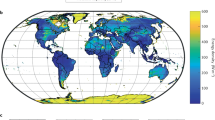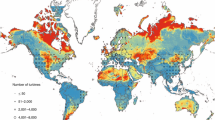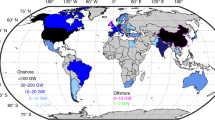Abstract
Estimates of wind power potential are relevant for decision-making in energy policy and business. Such estimates are affected by several uncertain assumptions, most significantly related to wind turbine technology and land use. Here, we calculate the technical and economic onshore wind power potentials with the aim to evaluate the impact of such assumptions using the case-study area of Finland as an example. We show that the assumptions regarding turbine technology and land use policy are highly significant for the potential estimate. Modern turbines with lower specific ratings and greater hub heights improve the wind power potential considerably, even though it was assumed that the larger rotors decrease the installation density and increase the turbine investment costs. New technology also decreases the impact of strict land use policies. Uncertainty in estimating the cost of wind power technology limits the accuracy of assessing economic wind power potential.
This is a preview of subscription content, access via your institution
Access options
Access Nature and 54 other Nature Portfolio journals
Get Nature+, our best-value online-access subscription
$29.99 / 30 days
cancel any time
Subscribe to this journal
Receive 12 digital issues and online access to articles
$119.00 per year
only $9.92 per issue
Buy this article
- Purchase on Springer Link
- Instant access to full article PDF
Prices may be subject to local taxes which are calculated during checkout




Similar content being viewed by others
References
Hoogwijk, M., de Vries, B. & Turkenburg, W. Assessment of the global and regional geographical, technical and economic potential of onshore wind energy. Energy Econ. 26, 889–919 (2004).
Chabot, B. Wind Power Silent Revolution: New Wind Turbines for Light Wind Sites (Renewables International, 2013).
Ender, C. & Neddermann, B. Wind energy use in Germany. DEWI Mag. 47, 62–66 (2016).
Wiser, R. & Bolinger, M. 2015 Wind Technologies Market Report. Technical Report (US Department of Energy, Washington, 2016).
McKenna, R., Ostman v.d. Leye, P. & Fichtner, W. Key challenges and prospects for large wind turbines. Renew. Sustain. Energy Rev. 53, 1212–1221 (2016).
Malcolm, D. J. & Cotrell, J. The influence of specific rating on the cost of wind energy in Collection of ASME Wind Energy Symposium Technical Papers AIAA Aerospace Sciences Meeting and Exhibit AIAA 2004-1006 (AIAA, Reston, VA, 2004).
Hirth, L. & Müller, S. System-friendly wind power. How advanced wind turbine design can increase the economic value of electricity generated through wind power. Energy Econ. 56, 51–63 (2016).
Europe’s Onshore and Offshore Wind Energy Potential—An Assessment of Environmental and Economic Constraints Technical Report 6/2009 (European Environment Agency, 2009).
Fueyo, N., Sanz, Y., Rodrigues, M., Montañés, C. & Dopazo, C. High resolution modelling of the on-shore technical wind energy potential in Spain. Wind Energy 13, 717–726 (2010).
Zhou, Y., Luckow, P., Smith, S. J. & Clarke, L. Evaluation of global onshore wind energy potential and generation costs. Environ. Sci. Technol. 46, 7857–7864 (2012).
Mentis, D., Hermann, S., Howells, M., Welsch, M. & Siyal, S. H. Assessing the technical wind energy potential in Africa—a GIS-based approach. Renew. Energy 83, 110–125 (2015).
Mentis, D., Siyal, S. H., Korkovelos, A. & Howells, M. A geospatial assessment of the techno-economic wind power potential in India using geographical restrictions. Renew. Energy 97, 77–88 (2016).
Lu, X., McElroy, M. B. & Kiviluoma, J. Global potential for wind-generated electricity. Proc. Natl Acad. Sci. USA 106, 10933–10938 (2009).
McKenna, R., Hollnaicher, S., Ostman v.d. Leye, P. & Fichtner, W. Cost-potentials for large onshore wind turbines in Europe. Energy 83, 217–229 (2015).
Ritter, M., Shen, Z., Cabrera, B. L., Odening, M. & Deckert, L. A new approach to assess wind energy potential. Energy Procedia 75, 671–676 (2015).
Silva Herran, D., Dai, H., Fujimori, S. & Masui, T. Global assessment of onshore wind power resources considering the distance to urban areas. Energy Policy 91, 75–86 (2016).
Jäger, T., McKenna, R. & Fichtner, W. The feasible onshore wind energy potential in Baden-Württemberg: a bottom-up methodology considering socio-economic constraints. Renew. Energy 96, 662–675 (2016).
Höltinger, S., Salak, B., Schauppenlehner, T., Scherhaufer, P. & Schmidt, J. Austria’s wind energy potential—a participatory modeling approach to assess socio-political and market acceptance. Energy Policy 98, 49–61 (2016).
Bosch, J., Staffell, I. & Hawkes, A. D. Temporally-explicit and spatially-resolved global onshore wind energy potentials. Energy 131, 207–217 (2017).
Kline, D., Heimiller, D., Cowlin, S. & Nrel. GIS Method for Developing Wind Supply Curves Technical Report NREL/TP-670-43053 (National Renewable Energy Laboratory, Golden, CO, 2008).
Eurek, K. et al. An improved global wind resource estimate for integrated assessment models. Energy Econ. 64, 552–567 (2017).
McKenna, R., Hollnaicher, S. & Fichtner, W. Cost–potential curves for onshore wind energy: a high-resolution analysis for Germany. Appl. Energy 115, 103–115 (2014).
Lütkehus, I. et al. Potenzial der Windenergie an Land Technical Report (Umweltbundesamt, Dessau-Roßlau, 2013).
Sliz-Szkliniarz, B. & Vogt, J. GIS-based approach for the evaluation of wind energy potential: a case study for the Kujawsko–Pomorskie Voivodeship. Renew. Sustain. Energy Rev. 15, 1696–1707 (2011).
Fingersh, L., Hand, M. & Laxson, A. Wind Turbine Design Cost and Scaling Model Technical Report NREL/TP-500-40566 (National Renewable Energy Laboratory, Golden, CO, 2006).
Siyal, S. H. et al. Wind energy assessment considering geographic and environmental restrictions in Sweden: a GIS-based approach. Energy 83, 447–461 (2015).
Finnish Wind Atlas (Finnish Meteorological Institute, 2008).
Tammelin, B. et al. Production of the Finnish Wind Atlas. Wind Energy 16, 19–35 (2013).
Wind Turbines—Part 1: Design Requirements IEC 61400-1 (International Electrotechnical Commission, 2005).
Wallasch, A.-K., Lüers, S., Rehfeldt, K. & Ekkert, M. Kostensituation der Windenergie an Land in Deutschland Technical Report SP13007A2 (Deutsche WindGuard GmbH, Varel, 2013).
Lüers, S., Wallasch, A.-K. & Rehfeldt, K. Kostensituation der Windenergia an Land in Deutschland – Update Technical Report SP15027A1 (Deutsche WindGuard, Varel, 2015).
Moné, C. et al. 2015 Cost of Wind Energy Review Technical Report NREL/TP-6A20-66861 (National Renewable Energy Laboratory, Golden, CO, 2017).
Energy Year 2016—Electricity (Finnish Energy, 2017).
Volker, P. J. H., Hahmann, A. N., Badger, J. & Jørgensen, H. E. Prospects for generating electricity by large onshore and offshore wind farms. Environ. Res. Lett. 12, 034022 (2017).
Corine Land Cover 2012 (Finnish Environment Institute (SYKE), 2014).
Wind power spatial planning techniques Global Atlas Training on Planning the Renewable Energy Transition Using Solar and Wind Maps Session 2a (IRENA, 2015).
Bredesen, R.E. et al. Wind Energy Projects in Cold Climates (IEA Wind, 2012); https://community.ieawind.org/task19/ourlibrary
Power Curves Database Version 2016-08-18 (The Wind Power, 2016).
Staffell, I. & Green, R. How does wind farm performance decline with age? Renew. Energy 66, 775–786 (2014).
Staffell, I. & Pfenninger, S. Using bias-corrected reanalysis to simulate current and future wind power output. Energy 114, 1224–1239 (2016).
Vakkilainen, E. & Kivistö, A. Comparison of electricity generation costs. Research Report 66, Lappeenranta University of Technology, Lappeenranta, Finland (2017).
Olauson, J., Edström, P. & Rydén, J. Wind turbine performance decline in Sweden. Wind Energy 20, 2049–2053 (2017).
Connection Fees (Fingrid Oyj, 2017).
Rinne, E. Capacity Factors for Wind Turbines (Zenedo, 2017); https://doi.org/10.5281/zenodo.582537
Turbines (Vestas Wind Systems, accessed 20 April 2017); https://www.vestas.com/en/products/turbines
Turbines Database Version 2015-12-07 (The Wind Power, 2015).
Natura 2000 Areas (Finnish Environment Institute (SYKE), 2012).
Nationally Designated Nature Protected Areas and Wilderness Reserves (Finnish Environment Institute (SYKE), 2013).
General Map 1:1,000,000 (National Land Survey of Finland, 2016).
Tuulivoimalaohje (Liikennevirasto, Helsinki, 2012).
Korkeusrajoitukset Paikkatietoaineistona (Finavia Oyj, 2016).
Acknowledgements
This work was supported by the Strategic Research Council at the Academy of Finland, project ‘Transition to a resource efficient and climate neutral electricity system (EL-TRAN)’, grant no. 314319. We thank E. Peltola and P. Antikainen at the VTT Technical Research Centre of Finland for the buffer radius estimates around miscellaneous land use functions (Supplementary Table 2).
Author information
Authors and Affiliations
Contributions
E.R. made the analysis, wrote the draft manuscript and was responsible for the final manuscript. H.H. and J.K. participated in the study design and in the writing of the manuscript. S.R. calculated the distances to roads and transmission grids and assessed icing losses, and also developed the methodology for calculating grid connection costs. All the authors commented on the manuscript.
Corresponding author
Ethics declarations
Competing interests
The authors declare no competing interests.
Additional information
Publisher’s note: Springer Nature remains neutral with regard to jurisdictional claims in published maps and institutional affiliations.
Supplementary information
Supplementary Information
Supplementary Figures 1–3, Supplementary Tables 1–5, Supplementary References
Rights and permissions
About this article
Cite this article
Rinne, E., Holttinen, H., Kiviluoma, J. et al. Effects of turbine technology and land use on wind power resource potential. Nat Energy 3, 494–500 (2018). https://doi.org/10.1038/s41560-018-0137-9
Received:
Accepted:
Published:
Issue Date:
DOI: https://doi.org/10.1038/s41560-018-0137-9
This article is cited by
-
Impact of siting ordinances on land availability for wind and solar development
Nature Energy (2023)
-
Development of onshore wind turbine fleet counteracts climate change-induced reduction in global capacity factor
Nature Energy (2022)
-
Scenicness assessment of onshore wind sites with geotagged photographs and impacts on approval and cost-efficiency
Nature Energy (2021)
-
State of the Art in the Optimisation of Wind Turbine Performance Using CFD
Archives of Computational Methods in Engineering (2020)
-
Observation-based estimates of land availability for wind power: a case study for Czechia
Energy, Sustainability and Society (2019)



